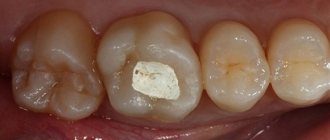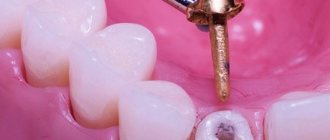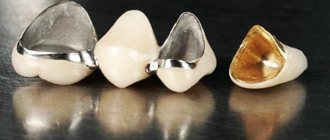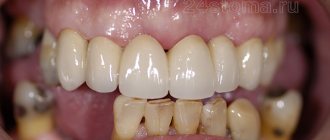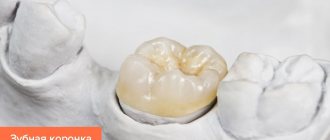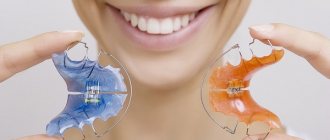Installing a temporary crown on an implant
Not all implantation methods involve installing a temporary crown on the implant. This is only possible when using a one-stage technique with instant loading. As a rule, the method is used to restore front teeth. The possibility of installing a temporary crown on an implant is also associated with the special structure of artificial roots used for one-stage implantation. Firstly, these implants are one-piece, that is, they are already connected to an abutment, onto which the prosthesis is then attached. And secondly, such structures are equipped with a special thread, so they seem to be screwed into the bone tissue without the need to drill out a place in it for the implant, as is done with the two-stage technique. In this regard, implants for a one-stage implantation procedure are attached more securely, and therefore are able to withstand the weight of a temporary crown and normal chewing load from the first days of installation.
Care of the provisional product
Since the plastic (plastic) crown is fixed on a temporary cement mortar, the fastening strength is low. If you chew toffee or gum, the likelihood of the product coming off the tooth is quite high. Therefore, during the period of operation, doctors recommend reducing the chewing activity of the area where the temporary structure is installed. Even when brushing your teeth, you need to be careful with the plastic so as not to damage it.
If the temporary crown comes off, you need to place it in a glass of water overnight, and the next day go to an appointment with a treating specialist.
Reception is conducted by specialists
Do I need a temporary crown for an implant?
Do I need to put temporary crowns on implants? If the operation is performed in the smile area, then it is advisable to do this. Natural pressure when chewing food will activate metabolic processes in bone tissue and stimulate their restoration. Moreover, the installed crown will help achieve a beautiful gum contour and also prevent the loss of soft tissue. As for the implantation of chewing teeth, according to most experts, it is better to carry out the operation in two stages with delayed installation of the crown.
Indirect method
The indirect manufacturing method of crowns involves obtaining a high-quality product that has a more aesthetic appearance and is characterized by significantly increased reliability indicators. The cost of such a product will be higher.
Making individual temporary crowns using the indirect method takes up to two days. The process takes place in three stages:
- taking a silicone impression;
- making a plaster jaw model;
- casting a polymer crown;
- correction of the product using a plaster model using modern technologies.
Models of temporary crowns when manufactured indirectly correspond to the anatomical features of the dentition, so they do not cause discomfort and problems with chewing food.
Making temporary crowns for implants
Temporary crowns for dental implants are in most cases made of plastic. Please note that metal-ceramics, all-ceramics and zirconium are used to make permanent crowns for implants. If a doctor offers to make a temporary crown, for example, from metal ceramics, think about his honesty and competence. It may happen that the same structure will be installed twice: as a temporary and permanent one. Of course, for a double fee.
What are they made from?
For the manufacture of dental temporary crowns, materials with low strength are used, which can be removed or removed from the surface of the tooth without injury. In addition, the use of expensive materials is not advisable, because the service life is on average 2-3 weeks.
Temporary crowns are made from materials:
- acrylic composition;
- plastic;
- composites.
The material used for the manufacture of dental orthopedic products must meet the following requirements:
- the hardening process occurs quickly, but the specialist has enough time for application and correction;
- melting is performed exclusively at low temperatures while maintaining the strength of the product.
The temporary crown must be safe for the patient and perform its functions taking into account the anatomical features of the jaw. If the design causes significant discomfort or causes an allergic reaction, it must be replaced.
How long does it take to make a temporary crown on an implant?
Direct method.
The doctor takes an impression using silicone mass, pours a plastic solution into it and puts it all on the implant. Once the resin has cured, the silicone impression is removed and the temporary crown remains on the implant. It is given the required shape, polished and ground, and then secured with special cement.
- Quickly produced.
- Similar to natural teeth.
- Porosity, due to which there is a risk of infection.
- Discoloration due to coloring products.
- Short service life.
- More fragile.
Indirect method.
Based on the casts, a plaster model of both jaws is created in the laboratory, which is used to make a wax crown. A temporary plastic crown is created using the wax model. Sometimes, in the manufacture of plastic crowns, a metal base is used to extend the service life of the products.
- More durable compared to crowns made using the direct method.
- The individual characteristics of the patient are taken into account.
- No.
Making temporary crowns for implants using the direct method in an orthopedist’s office will take no more than an hour. A dental laboratory will make a temporary crown made of plastic in a couple of days.
Metal-plastic crowns –
In addition to crowns made entirely of plastic, there are also so-called “metal-plastic crowns” (synonym – metal-plastic crowns). Such crowns have a metal frame, which is lined with a plastic overlay on the front side. Such crowns have more or less acceptable aesthetics, and also have a fairly long service life - up to 5 years.
Structurally, metal-plastic crowns for teeth are made like cast crowns (made of cobalt-chromium alloy) - with an additional plastic facet on the front surface. The advantage of such crowns is their more or less acceptable aesthetics, as well as maintainability. For example, if a plastic veneer chips, it can be repaired directly in the mouth, i.e. a metal-plastic crown does not require removal from the tooth for such repairs.
The disadvantages include their cost, which is already very close to the cost of economy-class metal ceramics made from budget materials (about 5,000 rubles in 2021). An absolute disadvantage is that plastic facets can quickly lose their aesthetic properties and negatively affect the condition of the gums around the crown. We hope that our article: Plastic crowns reviews was useful to you!
Sources:
1. Personal experience as a dentist, 2. “Orthopedic dentistry. Textbook" (Trezubov V.N.), 3. National Library of Medicine (USA), 4. https://www.realself.com/, 5. "Crowns and bridges in orthopedic dentistry" (Smith B.).
What to do if a temporary crown on an implant falls out or is swaying?
Sometimes temporary crowns on implants begin to wobble due to poor-quality fixation or poor implant abutment. However, there are cases when the patient cannot determine exactly what has become unstable - the temporary crown or the artificial root itself. Therefore, at the first signs of mobility of the temporary prosthesis on the implant, you should immediately contact the doctor who performed the implantation procedure. Only he will be able to correctly determine the condition of the artificial root and more securely attach a temporary crown to it.
How to remove a prosthesis
How are temporary crowns removed? It is worth noting that removal should only be carried out by a doctor. This procedure is painless and does not require any special preparation from the patient. But it should not be carried out by him himself. Let's look at the removal process step by step:
- the prosthesis is exposed to ultrasonic waves, from which the adhesive base begins to crumble,
- removal using a special tool (crown remover or Kopp apparatus): it has a small hook and lever,
- cement residues are removed from the support using ultrasound,
- diagnostics of the abutment tooth is carried out: for damage and inflammatory processes,
- a temporary or permanent prosthesis is installed: the choice depends on the stage of prosthetics.
Complex on 4 OSSTEM implants with delayed loading - from RUB 170,000.
Complex implantation Osstem (South Korea) with delayed loading after 4-6 months.
Guarantee for the doctor’s work - unlimited Call now or order a call
Opening hours: 24 hours a day - seven days a week
What to do if the crown falls out on its own? To avoid complications, you should put it in a clean container and contact your dentist. You cannot reinstall it yourself, otherwise you may damage the support or cause inflammation. Moreover, you should not use any adhesives not intended for the oral cavity, as well as chewing gum.
Why are temporary crowns placed before permanent ones?
It may seem that a temporary crown is an extra material cost and should not be included in the cost of prosthetics.
Let us dwell once again on the need to use temporary crowns and emphasize their main advantages.
- Psychological calm.
Imitating your own teeth allows you to maintain self-confidence without introducing an imbalance in your daily activities (during business negotiations, smiling, talking, etc.). - Safety of soft tissues of the oral cavity
(prevention of inflammation and atrophy). - Preserving the functionality of teeth.
Thanks to the complete chewing process, possible undesirable consequences for the digestive system are eliminated. - No problems with diction.
- Fast adaptation.
Getting used to the future permanent prosthesis is much easier if you wear temporary crowns first. - Economy.
A temporary crown is a quick “reanimation” of teeth at an affordable cost.
How to combine Function and Aesthetics in an orthopedic design?
At the beginning of the article, we mentioned two main requirements for a crown and we believe you already know that any well-designed and manufactured denture should satisfy these requirements as well as possible.
Of course, not every clinical case and not every treatment plan chosen by the patient implies a complete restoration of dental function and smile aesthetics .
For example, an inexpensive removable denture will be less comfortable and aesthetically pleasing than a permanent denture made from modern materials using the best technologies, but when implementing any treatment plan, the dentist always thinks about how to achieve maximum comfort and beauty for the patient under the existing restrictions.
And most often, it is the stage of temporary prosthetics that allows us to provide for all the nuances.
How long can you walk with a temporary crown?
Temporary crowns are a quick restoration of the aesthetics and functionality of teeth until permanent dentures are installed. Their service life is the time required to create permanent orthopedic structures, as well as implant healing. When can a permanent prosthesis be installed on an implant? Up to 4 months is the healing period of the implant in the lower jaw, up to 6 months in the upper jaw. After this, permanent dental prosthetics can be performed.
In some cases, for example, after implantation of All-on-4, All-on-6, a temporary prosthesis can last up to two years. During this time, the patient will have time to financially prepare for the installation of a high-quality permanent prosthesis. If the patient uses a temporary crown for a long time, it is necessary to come to the clinic every six months for a preventive examination. When worn for a long time, the following complications may occur:
✔
abrasion of crowns, leading to displacement of adjacent teeth;
✔
inflammation of the gums due to the accumulation of bacteria on plastic;
✔
gum growth and pain due to damage to the crown.
To make a temporary crown on an implant last longer:
- avoid sticky and hard foods;
- brush your teeth gently, without pressing hard on the area where the implant is installed;
- floss as carefully as possible.
The role of “temporary solutions” in the case of dental implantation
If one or more teeth have been missing for a long time, and also if the tooth was deliberately “removed from the bite” in order to reduce the load until it is restored, the task of the temporary restoration is “to load the teeth and help them remember their function.” In this way, the correct distribution of the chewing load is restored and the functioning of the entire dental system is improved.
Temporary restorations, made from softer materials than permanent ones, prevent injury to the teeth until the doctor selects their ideal closure.
During this period, the shape of the teeth being restored is corrected and it is easier and cheaper to do this with a temporary restoration. A correctly selected tooth shape prevents accelerated abrasion and chipping, both on the restored tooth and on opposing teeth.
Inaccuracies in the anatomical shape can not only cause discomfort to the patient and lead to chips of the enamel, but in the future cause diseases of the temporomandibular joint if it does not adapt to the new bite.
Another important task of temporary restoration, especially when it comes to restoring a missing tooth with an implant, is creating the correct gingival contour around the future permanent crown.
Temporary crowns allow you to create a beautiful and natural gum contour in place of a lost tooth.
Why else are temporary crowns needed if the tooth is restored with an implant?
For example, in order not to leave empty space in the dentition, because this can lead to the displacement of adjacent teeth and antagonist teeth.
Now you know almost everything “why” an orthopedic doctor may recommend the temporary prosthetics stage.
Of course, temporary restorations are not used in all cases, but this will be known during the consultation after examination and diagnosis.
Wearing period
There is no point in wearing temporary crowns for a long time; they are usually used until the time comes to install permanent structures. On average, this is no more than two weeks, but in complex cases it may take a little longer. In any case, the attending physician will definitely orient his patient regarding the timing of treatment.
Of course, if desired, the patient can wear temporary dentures for several months. But over time, chips may appear on them, and they may change the original shade. A temporary crown helps to quickly get used to a permanent prosthesis; as a result, a person does not feel discomfort and practically does not feel the presence of a foreign object in the mouth.
The cost of such crowns will largely depend on the material used by the master, as well as on the manufacturing method. The direct method allows for significant savings; ready-made dentures also cost less. In this case, you will have to choose: high quality and aesthetic component or low cost.
Contraindications for use
Plastic crowns have no serious contraindications, with the exception of the occasional allergic reaction to any of the plastic components. In childhood, temporary prostheses are also usually not installed. Such crowns are used with caution in patients with bruxism, as well as permanent dentures, since tooth compression negatively affects the crowns and contributes to their wear ahead of time. At night, patients are advised to wear a special mouth guard to prevent teeth grinding.
